案例:该数据集的是一个关于每个学生成绩的数据集,接下来我们对该数据集进行分析,判断学生是否适合继续深造
数据集特征展示
1 GRE 成绩 (290 to 340) 2 TOEFL 成绩(92 to 120) 3 学校等级 (1 to 5) 4 自身的意愿 (1 to 5) 5 推荐信的力度 (1 to 5) 6 CGPA成绩 (6.8 to 9.92) 7 是否有研习经验 (0 or 1) 8 读硕士的意向 (0.34 to 0.97)
1.导入包
import numpy as np import pandas as pd import matplotlib.pyplot as plt import seaborn as sns import os,sys
2.导入并查看数据集
df = pd.read_csv("D:\machine-learning\score\Admission_Predict.csv",sep = ",")
print('There are ',len(df.columns),'columns')
for c in df.columns:
sys.stdout.write(str(c)+', '
There are 9 columns Serial No., GRE Score, TOEFL Score, University Rating, SOP, LOR , CGPA, Research, Chance of Admit ,
一共有9列特征
df.info()
<class 'pandas.core.frame.DataFrame'> RangeIndex: 400 entries, 0 to 399 Data columns (total 9 columns): Serial No. 400 non-null int64 GRE Score 400 non-null int64 TOEFL Score 400 non-null int64 University Rating 400 non-null int64 SOP 400 non-null float64 LOR 400 non-null float64 CGPA 400 non-null float64 Research 400 non-null int64 Chance of Admit 400 non-null float64 dtypes: float64(4), int64(5) memory usage: 28.2 KB
数据集信息:
1.数据有9个特征,分别是学号,GRE分数,托福分数,学校等级,SOP,LOR,CGPA,是否参加研习,进修的几率
2.数据集中没有空值
3.一共有400条数据
# 整理列名称 df = df.rename(columns={'Chance of Admit ':'Chance of Admit'})
# 显示前5列数据
df.head()

3.查看每个特征的相关性
fig,ax = plt.subplots(figsize=(10,10)) sns.heatmap(df.corr(),ax=ax,annot=True,linewidths=0.05,fmt='.2f',cmap='magma') plt.show()
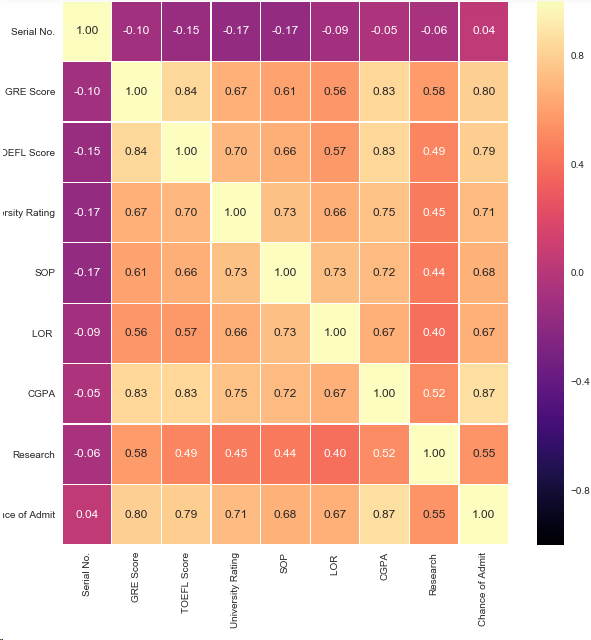
结论:1.最有可能影响是否读硕士的特征是GRE,CGPA,TOEFL成绩
2.影响相对较小的特征是LOR,SOP,和Research
4.数据可视化,双变量分析
4.1 进行Research的人数
print("Not Having Research:",len(df[df.Research == 0])) print("Having Research:",len(df[df.Research == 1])) y = np.array([len(df[df.Research == 0]),len(df[df.Research == 1])]) x = np.arange(2) plt.bar(x,y) plt.title("Research Experience") plt.xlabel("Canditates") plt.ylabel("Frequency") plt.xticks(x,('Not having research','Having research')) plt.show()
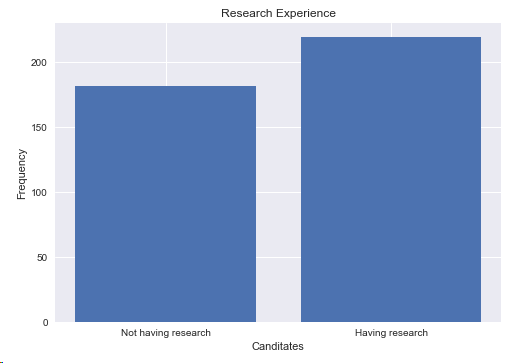
结论:进行research的人数是219,本科没有research人数是181
4.2 学生的托福成绩
y = np.array([df['TOEFL Score'].min(),df['TOEFL Score'].mean(),df['TOEFL Score'].max()]) x = np.arange(3) plt.bar(x,y) plt.title('TOEFL Score') plt.xlabel('Level') plt.ylabel('TOEFL Score') plt.xticks(x,('Worst','Average','Best')) plt.show()
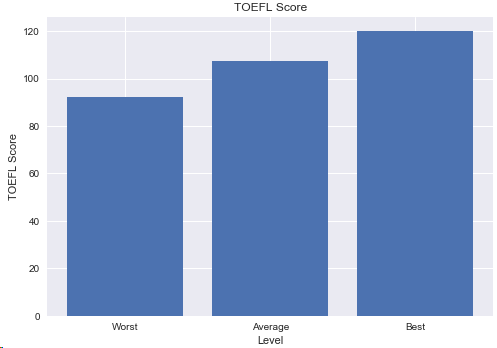
结论:最低分92分,最高分满分,进修学生的英语成绩很不错
4.3 GRE成绩
df['GRE Score'].plot(kind='hist',bins=200,figsize=(6,6)) plt.title('GRE Score') plt.xlabel('GRE Score') plt.ylabel('Frequency') plt.show()
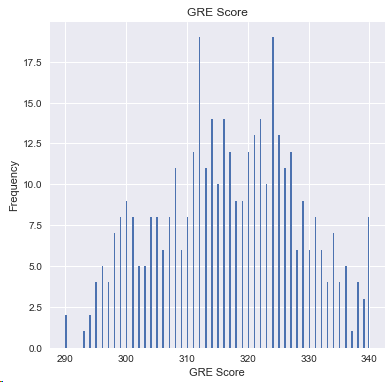
结论:310和330的分值的学生居多
4.4 CGPA和学校等级的关系
plt.scatter(df['University Rating'],df['CGPA']) plt.title('CGPA Scores for University ratings') plt.xlabel('University Rating') plt.ylabel('CGPA') plt.show()
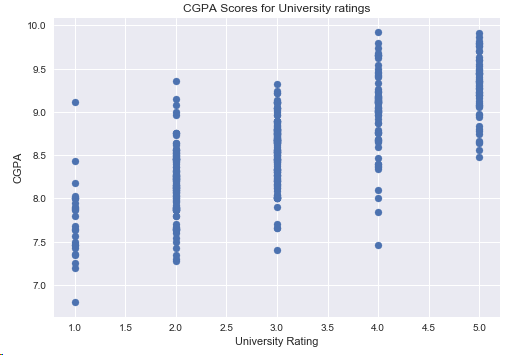
结论:学校越好,学生的GPA可能就越高
4.5 GRE成绩和CGPA的关系
plt.scatter(df['GRE Score'],df['CGPA']) plt.title('CGPA for GRE Scores') plt.xlabel('GRE Score') plt.ylabel('CGPA') plt.show()
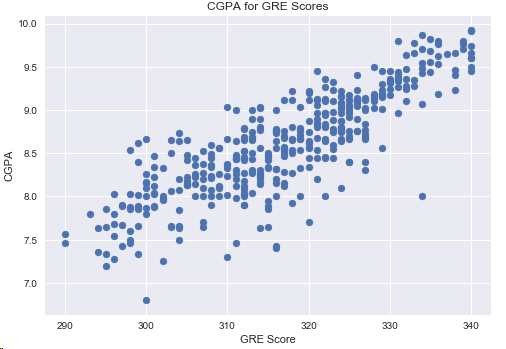
结论:GPA基点越高,GRE分数越高,2者的相关性很大
4.6 托福成绩和GRE成绩的关系
df[df['CGPA']>=8.5].plot(kind='scatter',x='GRE Score',y='TOEFL Score',color='red') plt.xlabel('GRE Score') plt.ylabel('TOEFL Score') plt.title('CGPA >= 8.5') plt.grid(True) plt.show()

结论:多数情况下GRE和托福成正相关,但是GRE分数高,托福一定高。
4.6 学校等级和是否读硕士的关系
s = df[df['Chance of Admit'] >= 0.75]['University Rating'].value_counts().head(5) plt.title('University Ratings of Candidates with an 75% acceptance chance') s.plot(kind='bar',figsize=(20,10),cmap='Pastel1') plt.xlabel('University Rating') plt.ylabel('Candidates') plt.show()

结论:排名靠前的学校的学生,进修的可能性更大
4.7 SOP和GPA的关系
plt.scatter(df['CGPA'],df['SOP']) plt.xlabel('CGPA') plt.ylabel('SOP') plt.title('SOP for CGPA') plt.show()
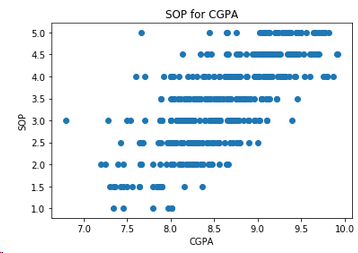
结论: GPA很高的学生,选择读硕士的自我意愿更强烈
4.8 SOP和GRE的关系
plt.scatter(df['GRE Score'],df['SOP']) plt.xlabel('GRE Score') plt.ylabel('SOP') plt.title('SOP for GRE Score') plt.show()
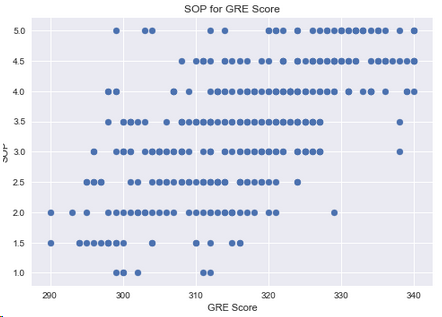
结论:读硕士意愿强的学生,GRE分数较高
5.模型
5.1 准备数据集
# 读取数据集 df = pd.read_csv('D:\machine-learning\score\Admission_Predict.csv',sep=',') serialNO = df['Serial No.'].values df.drop(['Serial No.'],axis=1,inplace=True) df = df.rename(columns={'Chance of Admit ':'Chance of Admit'}) # 分割数据集 y = df['Chance of Admit'].values x = df.drop(['Chance of Admit'],axis=1) from sklearn.model_selection import train_test_split x_train,x_test,y_train,y_test = train_test_split(x,y,test_size=0.2,random_state=42)
# 归一化数据
from sklearn.preprocessing import MinMaxScaler
scaleX = MinMaxScaler(feature_range=[0,1])
x_train[x_train.columns] = scaleX.fit_transform(x_train[x_train.columns])
x_test[x_test.columns] = scaleX.fit_transform(x_test[x_test.columns])
5.2 回归
5.2.1 线性回归
from sklearn.linear_model import LinearRegression lr = LinearRegression() lr.fit(x_train,y_train) y_head_lr = lr.predict(x_test) print('Real value of y_test[1]: '+str(y_test[1]) + ' -> predict value: ' + str(lr.predict(x_test.iloc[[1],:]))) print('Real value of y_test[2]: '+str(y_test[2]) + ' -> predict value: ' + str(lr.predict(x_test.iloc[[2],:]))) from sklearn.metrics import r2_score print('r_square score: ',r2_score(y_test,y_head_lr)) y_head_lr_train = lr.predict(x_train) print('r_square score(train data):',r2_score(y_train,y_head_lr_train))

5.2.2 随机森林回归
from sklearn.ensemble import RandomForestRegressor rfr = RandomForestRegressor(n_estimators=100,random_state=42) rfr.fit(x_train,y_train) y_head_rfr = rfr.predict(x_test) print('Real value of y_test[1]: '+str(y_test[1]) + ' -> predict value: ' + str(rfr.predict(x_test.iloc[[1],:]))) print('Real value of y_test[2]: '+str(y_test[2]) + ' -> predict value: ' + str(rfr.predict(x_test.iloc[[2],:]))) from sklearn.metrics import r2_score print('r_square score: ',r2_score(y_test,y_head_rfr)) y_head_rfr_train = rfr.predict(x_train) print('r_square score(train data):',r2_score(y_train,y_head_rfr_train))

5.2.3 决策树回归
from sklearn.tree import DecisionTreeRegressor dt = DecisionTreeRegressor(random_state=42) dt.fit(x_train,y_train) y_head_dt = dt.predict(x_test) print('Real value of y_test[1]: '+str(y_test[1]) + ' -> predict value: ' + str(dt.predict(x_test.iloc[[1],:]))) print('Real value of y_test[2]: '+str(y_test[2]) + ' -> predict value: ' + str(dt.predict(x_test.iloc[[2],:]))) from sklearn.metrics import r2_score print('r_square score: ',r2_score(y_test,y_head_dt)) y_head_dt_train = dt.predict(x_train) print('r_square score(train data):',r2_score(y_train,y_head_dt_train))

5.2.4 三种回归方法比较
y = np.array([r2_score(y_test,y_head_lr),r2_score(y_test,y_head_rfr),r2_score(y_test,y_head_dt)]) x = np.arange(3) plt.bar(x,y) plt.title('Comparion of Regression Algorithms') plt.xlabel('Regression') plt.ylabel('r2_score') plt.xticks(x,("LinearRegression","RandomForestReg.","DecisionTreeReg.")) plt.show()

结论 : 回归算法中,线性回归的性能更优
5.2.5 三种回归方法与实际值的比较
red = plt.scatter(np.arange(0,80,5),y_head_lr[0:80:5],color='red') blue = plt.scatter(np.arange(0,80,5),y_head_rfr[0:80:5],color='blue') green = plt.scatter(np.arange(0,80,5),y_head_dt[0:80:5],color='green') black = plt.scatter(np.arange(0,80,5),y_test[0:80:5],color='black') plt.title('Comparison of Regression Algorithms') plt.xlabel('Index of candidate') plt.ylabel('Chance of admit') plt.legend([red,blue,green,black],['LR','RFR','DT','REAL']) plt.show()
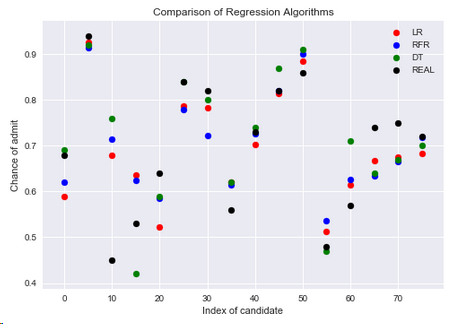
结论:在数据集中有70%的候选人有可能读硕士,从上图来看还有些点没有很好的得到预测
5.3 分类算法
5.3.1 准备数据
df = pd.read_csv('D:\machine-learning\score\Admission_Predict.csv',sep=',') SerialNO = df['Serial No.'].values df.drop(['Serial No.'],axis=1,inplace=True) df = df.rename(columns={'Chance of Admit ':'Chance of Admit'}) y = df['Chance of Admit'].values x = df.drop(['Chance of Admit'],axis=1) from sklearn.model_selection import train_test_split x_train,x_test,y_train,y_test = train_test_split(x,y,test_size=0.2,random_state=42) from sklearn.preprocessing import MinMaxScaler scaleX = MinMaxScaler(feature_range=[0,1]) x_train[x_train.columns] = scaleX.fit_transform(x_train[x_train.columns]) x_test[x_test.columns] = scaleX.fit_transform(x_test[x_test.columns]) # 如果chance >0.8, chance of admit 就是1,否则就是0 y_train_01 = [1 if each > 0.8 else 0 for each in y_train] y_test_01 = [1 if each > 0.8 else 0 for each in y_test] y_train_01 = np.array(y_train_01) y_test_01 = np.array(y_test_01)
5.3.2 逻辑回归
from sklearn.linear_model import LogisticRegression lrc = LogisticRegression() lrc.fit(x_train,y_train_01) print('score: ',lrc.score(x_test,y_test_01)) print('Real value of y_test_01[1]: '+str(y_test_01[1]) + ' -> predict value: ' + str(lrc.predict(x_test.iloc[[1],:]))) print('Real value of y_test_01[2]: '+str(y_test_01[2]) + ' -> predict value: ' + str(lrc.predict(x_test.iloc[[2],:]))) from sklearn.metrics import confusion_matrix cm_lrc = confusion_matrix(y_test_01,lrc.predict(x_test)) f,ax = plt.subplots(figsize=(5,5)) sns.heatmap(cm_lrc,annot=True,linewidths=0.5,linecolor='red',fmt='.0f',ax=ax) plt.title('Test for Test dataset') plt.xlabel('predicted y values') plt.ylabel('real y value') plt.show() from sklearn.metrics import recall_score,precision_score,f1_score print('precision_score is : ',precision_score(y_test_01,lrc.predict(x_test))) print('recall_score is : ',recall_score(y_test_01,lrc.predict(x_test))) print('f1_score is : ',f1_score(y_test_01,lrc.predict(x_test))) # Test for Train Dataset: cm_lrc_train = confusion_matrix(y_train_01,lrc.predict(x_train)) f,ax = plt.subplots(figsize=(5,5)) sns.heatmap(cm_lrc_train,annot=True,linewidths=0.5,linecolor='blue',fmt='.0f',ax=ax) plt.title('Test for Train dataset') plt.xlabel('predicted y values') plt.ylabel('real y value') plt.show()
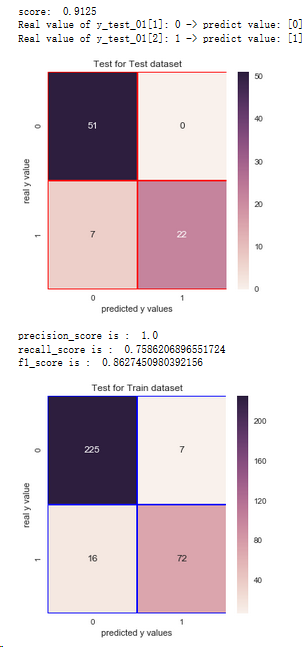
结论:1.通过混淆矩阵,逻辑回归算法在训练集样本上,有23个分错的样本,有72人想进一步读硕士
2.在测试集上有7个分错的样本
5.3.3 支持向量机(SVM)
from sklearn.svm import SVC svm = SVC(random_state=1,kernel='rbf') svm.fit(x_train,y_train_01) print('score: ',svm.score(x_test,y_test_01)) print('Real value of y_test_01[1]: '+str(y_test_01[1]) + ' -> predict value: ' + str(svm.predict(x_test.iloc[[1],:]))) print('Real value of y_test_01[2]: '+str(y_test_01[2]) + ' -> predict value: ' + str(svm.predict(x_test.iloc[[2],:]))) from sklearn.metrics import confusion_matrix cm_svm = confusion_matrix(y_test_01,svm.predict(x_test)) f,ax = plt.subplots(figsize=(5,5)) sns.heatmap(cm_svm,annot=True,linewidths=0.5,linecolor='red',fmt='.0f',ax=ax) plt.title('Test for Test dataset') plt.xlabel('predicted y values') plt.ylabel('real y value') plt.show() from sklearn.metrics import recall_score,precision_score,f1_score print('precision_score is : ',precision_score(y_test_01,svm.predict(x_test))) print('recall_score is : ',recall_score(y_test_01,svm.predict(x_test))) print('f1_score is : ',f1_score(y_test_01,svm.predict(x_test))) # Test for Train Dataset: cm_svm_train = confusion_matrix(y_train_01,svm.predict(x_train)) f,ax = plt.subplots(figsize=(5,5)) sns.heatmap(cm_svm_train,annot=True,linewidths=0.5,linecolor='blue',fmt='.0f',ax=ax) plt.title('Test for Train dataset') plt.xlabel('predicted y values') plt.ylabel('real y value') plt.show()
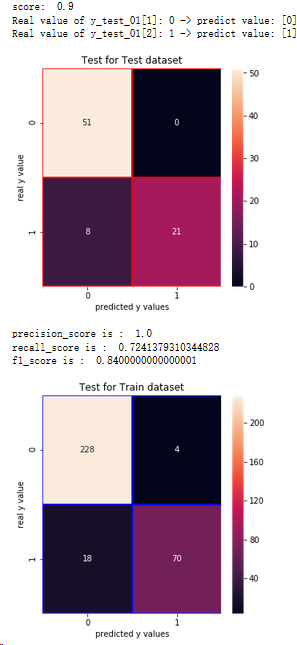
结论:1.通过混淆矩阵,SVM算法在训练集样本上,有22个分错的样本,有70人想进一步读硕士
2.在测试集上有8个分错的样本
5.3.4 朴素贝叶斯
from sklearn.naive_bayes import GaussianNB nb = GaussianNB() nb.fit(x_train,y_train_01) print('score: ',nb.score(x_test,y_test_01)) print('Real value of y_test_01[1]: '+str(y_test_01[1]) + ' -> predict value: ' + str(nb.predict(x_test.iloc[[1],:]))) print('Real value of y_test_01[2]: '+str(y_test_01[2]) + ' -> predict value: ' + str(nb.predict(x_test.iloc[[2],:]))) from sklearn.metrics import confusion_matrix cm_nb = confusion_matrix(y_test_01,nb.predict(x_test)) f,ax = plt.subplots(figsize=(5,5)) sns.heatmap(cm_nb,annot=True,linewidths=0.5,linecolor='red',fmt='.0f',ax=ax) plt.title('Test for Test dataset') plt.xlabel('predicted y values') plt.ylabel('real y value') plt.show() from sklearn.metrics import recall_score,precision_score,f1_score print('precision_score is : ',precision_score(y_test_01,nb.predict(x_test))) print('recall_score is : ',recall_score(y_test_01,nb.predict(x_test))) print('f1_score is : ',f1_score(y_test_01,nb.predict(x_test))) # Test for Train Dataset: cm_nb_train = confusion_matrix(y_train_01,nb.predict(x_train)) f,ax = plt.subplots(figsize=(5,5)) sns.heatmap(cm_nb_train,annot=True,linewidths=0.5,linecolor='blue',fmt='.0f',ax=ax) plt.title('Test for Train dataset') plt.xlabel('predicted y values') plt.ylabel('real y value') plt.show()
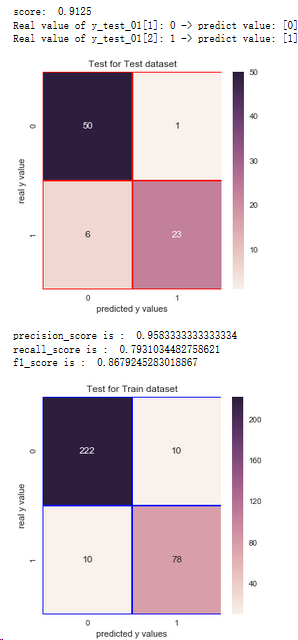
结论:1.通过混淆矩阵,朴素贝叶斯算法在训练集样本上,有20个分错的样本,有78人想进一步读硕士
2.在测试集上有7个分错的样本
5.3.5 随机森林分类器
from sklearn.ensemble import RandomForestClassifier rfc = RandomForestClassifier(n_estimators=100,random_state=1) rfc.fit(x_train,y_train_01) print('score: ',rfc.score(x_test,y_test_01)) print('Real value of y_test_01[1]: '+str(y_test_01[1]) + ' -> predict value: ' + str(rfc.predict(x_test.iloc[[1],:]))) print('Real value of y_test_01[2]: '+str(y_test_01[2]) + ' -> predict value: ' + str(rfc.predict(x_test.iloc[[2],:]))) from sklearn.metrics import confusion_matrix cm_rfc = confusion_matrix(y_test_01,rfc.predict(x_test)) f,ax = plt.subplots(figsize=(5,5)) sns.heatmap(cm_rfc,annot=True,linewidths=0.5,linecolor='red',fmt='.0f',ax=ax) plt.title('Test for Test dataset') plt.xlabel('predicted y values') plt.ylabel('real y value') plt.show() from sklearn.metrics import recall_score,precision_score,f1_score print('precision_score is : ',precision_score(y_test_01,rfc.predict(x_test))) print('recall_score is : ',recall_score(y_test_01,rfc.predict(x_test))) print('f1_score is : ',f1_score(y_test_01,rfc.predict(x_test))) # Test for Train Dataset: cm_rfc_train = confusion_matrix(y_train_01,rfc.predict(x_train)) f,ax = plt.subplots(figsize=(5,5)) sns.heatmap(cm_rfc_train,annot=True,linewidths=0.5,linecolor='blue',fmt='.0f',ax=ax) plt.title('Test for Train dataset') plt.xlabel('predicted y values') plt.ylabel('real y value') plt.show()

结论:1.通过混淆矩阵,随机森林算法在训练集样本上,有0个分错的样本,有88人想进一步读硕士
2.在测试集上有5个分错的样本
5.3.6 决策树分类器
from sklearn.tree import DecisionTreeClassifier dtc = DecisionTreeClassifier(criterion='entropy',max_depth=3) dtc.fit(x_train,y_train_01) print('score: ',dtc.score(x_test,y_test_01)) print('Real value of y_test_01[1]: '+str(y_test_01[1]) + ' -> predict value: ' + str(dtc.predict(x_test.iloc[[1],:]))) print('Real value of y_test_01[2]: '+str(y_test_01[2]) + ' -> predict value: ' + str(dtc.predict(x_test.iloc[[2],:]))) from sklearn.metrics import confusion_matrix cm_dtc = confusion_matrix(y_test_01,dtc.predict(x_test)) f,ax = plt.subplots(figsize=(5,5)) sns.heatmap(cm_dtc,annot=True,linewidths=0.5,linecolor='red',fmt='.0f',ax=ax) plt.title('Test for Test dataset') plt.xlabel('predicted y values') plt.ylabel('real y value') plt.show() from sklearn.metrics import recall_score,precision_score,f1_score print('precision_score is : ',precision_score(y_test_01,dtc.predict(x_test))) print('recall_score is : ',recall_score(y_test_01,dtc.predict(x_test))) print('f1_score is : ',f1_score(y_test_01,dtc.predict(x_test))) # Test for Train Dataset: cm_dtc_train = confusion_matrix(y_train_01,dtc.predict(x_train)) f,ax = plt.subplots(figsize=(5,5)) sns.heatmap(cm_dtc_train,annot=True,linewidths=0.5,linecolor='blue',fmt='.0f',ax=ax) plt.title('Test for Train dataset') plt.xlabel('predicted y values') plt.ylabel('real y value') plt.show()
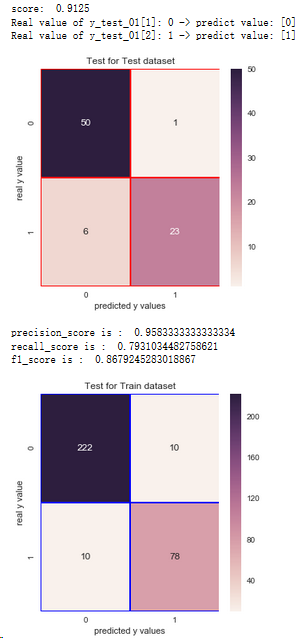
结论:1.通过混淆矩阵,决策树算法在训练集样本上,有20个分错的样本,有78人想进一步读硕士
2.在测试集上有7个分错的样本
5.3.7 K临近分类器
from sklearn.neighbors import KNeighborsClassifier scores = [] for each in range(1,50): knn_n = KNeighborsClassifier(n_neighbors = each) knn_n.fit(x_train,y_train_01) scores.append(knn_n.score(x_test,y_test_01)) plt.plot(range(1,50),scores) plt.xlabel('k') plt.ylabel('Accuracy') plt.show() knn = KNeighborsClassifier(n_neighbors=7) knn.fit(x_train,y_train_01) print('score 7 : ',knn.score(x_test,y_test_01)) print('Real value of y_test_01[1]: '+str(y_test_01[1]) + ' -> predict value: ' + str(knn.predict(x_test.iloc[[1],:]))) print('Real value of y_test_01[2]: '+str(y_test_01[2]) + ' -> predict value: ' + str(knn.predict(x_test.iloc[[2],:]))) from sklearn.metrics import confusion_matrix cm_knn = confusion_matrix(y_test_01,knn.predict(x_test)) f,ax = plt.subplots(figsize=(5,5)) sns.heatmap(cm_knn,annot=True,linewidths=0.5,linecolor='red',fmt='.0f',ax=ax) plt.title('Test for Test dataset') plt.xlabel('predicted y values') plt.ylabel('real y value') plt.show() from sklearn.metrics import recall_score,precision_score,f1_score print('precision_score is : ',precision_score(y_test_01,knn.predict(x_test))) print('recall_score is : ',recall_score(y_test_01,knn.predict(x_test))) print('f1_score is : ',f1_score(y_test_01,knn.predict(x_test))) # Test for Train Dataset: cm_knn_train = confusion_matrix(y_train_01,knn.predict(x_train)) f,ax = plt.subplots(figsize=(5,5)) sns.heatmap(cm_knn_train,annot=True,linewidths=0.5,linecolor='blue',fmt='.0f',ax=ax) plt.title('Test for Train dataset') plt.xlabel('predicted y values') plt.ylabel('real y value') plt.show()


结论:1.通过混淆矩阵,K临近算法在训练集样本上,有22个分错的样本,有71人想进一步读硕士
2.在测试集上有7个分错的样本
5.3.8 分类器比较
y = np.array([lrc.score(x_test,y_test_01),svm.score(x_test,y_test_01),nb.score(x_test,y_test_01), dtc.score(x_test,y_test_01),rfc.score(x_test,y_test_01),knn.score(x_test,y_test_01)]) x = np.arange(6) plt.bar(x,y) plt.title('Comparison of Classification Algorithms') plt.xlabel('Classification') plt.ylabel('Score') plt.xticks(x,("LogisticReg.","SVM","GNB","Dec.Tree","Ran.Forest","KNN")) plt.show()

结论:随机森林和朴素贝叶斯二者的预测值都比较高
5.4 聚类算法
5.4.1 准备数据
df = pd.read_csv('D:\machine-learning\score\Admission_Predict.csv',sep=',') df = df.rename(columns={'Chance of Admit ':'Chance of Admit'}) serialNo = df['Serial No.'] df.drop(['Serial No.'],axis=1,inplace=True) df = (df - np.min(df)) / (np.max(df)-np.min(df)) y = df['Chance of Admit'] x = df.drop(['Chance of Admit'],axis=1)
5.4.2 降维
from sklearn.decomposition import PCA pca = PCA(n_components=1,whiten=True) pca.fit(x) x_pca = pca.transform(x) x_pca = x_pca.reshape(400) dictionary = {'x':x_pca,'y':y} data = pd.DataFrame(dictionary) print('pca data:',data.head()) print() print('orin data:',df.head())
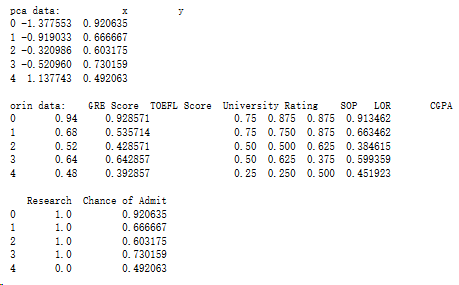
5.4.3 K均值聚类
from sklearn.cluster import KMeans wcss = [] for k in range(1,15): kmeans = KMeans(n_clusters=k) kmeans.fit(x) wcss.append(kmeans.inertia_) plt.plot(range(1,15),wcss) plt.xlabel('Kmeans') plt.ylabel('WCSS') plt.show() df["Serial No."] = serialNo kmeans = KMeans(n_clusters=3) clusters_knn = kmeans.fit_predict(x) df['label_kmeans'] = clusters_knn plt.scatter(df[df.label_kmeans == 0 ]["Serial No."],df[df.label_kmeans == 0]['Chance of Admit'],color = "red") plt.scatter(df[df.label_kmeans == 1 ]["Serial No."],df[df.label_kmeans == 1]['Chance of Admit'],color = "blue") plt.scatter(df[df.label_kmeans == 2 ]["Serial No."],df[df.label_kmeans == 2]['Chance of Admit'],color = "green") plt.title("K-means Clustering") plt.xlabel("Candidates") plt.ylabel("Chance of Admit") plt.show() plt.scatter(data.x[df.label_kmeans == 0 ],data[df.label_kmeans == 0].y,color = "red") plt.scatter(data.x[df.label_kmeans == 1 ],data[df.label_kmeans == 1].y,color = "blue") plt.scatter(data.x[df.label_kmeans == 2 ],data[df.label_kmeans == 2].y,color = "green") plt.title("K-means Clustering") plt.xlabel("X") plt.ylabel("Chance of Admit") plt.show()
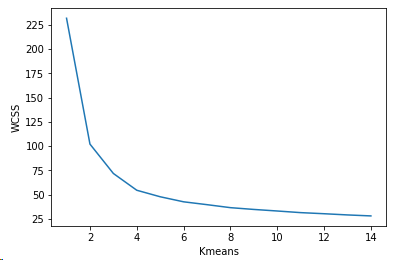
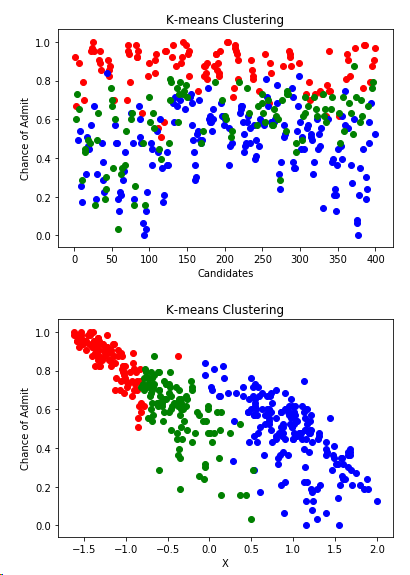
结论:数据集分成三个类别,一部分学生是决定继续读硕士,一部分放弃,还有一部分学生的比较犹豫,但是深造的可能性较大
5.4.4 层次聚类
from scipy.cluster.hierarchy import linkage,dendrogram merg = linkage(x,method='ward') dendrogram(merg,leaf_rotation=90) plt.xlabel('data points') plt.ylabel('euclidean distance') plt.show() from sklearn.cluster import AgglomerativeClustering hiyerartical_cluster = AgglomerativeClustering(n_clusters=3,affinity='euclidean',linkage='ward') clusters_hiyerartical = hiyerartical_cluster.fit_predict(x) df['label_hiyerartical'] = clusters_hiyerartical plt.scatter(df[df.label_hiyerartical == 0 ]["Serial No."],df[df.label_hiyerartical == 0]['Chance of Admit'],color = "red") plt.scatter(df[df.label_hiyerartical == 1 ]["Serial No."],df[df.label_hiyerartical == 1]['Chance of Admit'],color = "blue") plt.scatter(df[df.label_hiyerartical == 2 ]["Serial No."],df[df.label_hiyerartical == 2]['Chance of Admit'],color = "green") plt.title('Hierarchical Clustering') plt.xlabel('Candidates') plt.ylabel('Chance of Admit') plt.show() plt.scatter(data[df.label_hiyerartical == 0].x,data.y[df.label_hiyerartical==0],color='red') plt.scatter(data[df.label_hiyerartical == 1].x,data.y[df.label_hiyerartical==1],color='blue') plt.scatter(data[df.label_hiyerartical == 2].x,data.y[df.label_hiyerartical==2],color='green') plt.title('Hierarchical Clustering') plt.xlabel('X') plt.ylabel('Chance of Admit') plt.show()
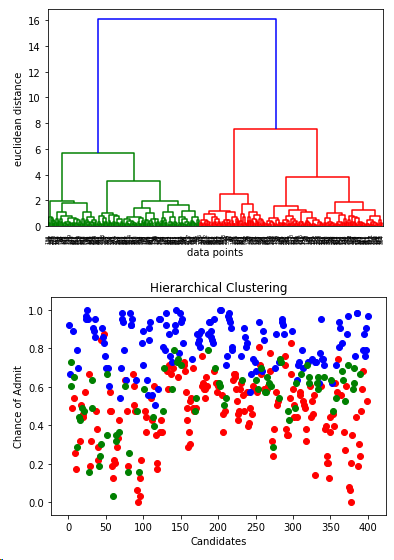

结论:从层次聚类的结果中,可以看出和K均值聚类的结果一致,只不过确定了聚类k的取值3
结论:通过本词入门数据集的训练,可以掌握
1.一些特征的展示的方法
2.如何调用sklearn 的API
3.如何取比较不同模型之间的好坏
代码+数据集:https://github.com/Mounment/python-data-analyze/tree/master/kaggle/score
如果有用的话,记得打一个星星,谢谢
